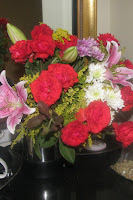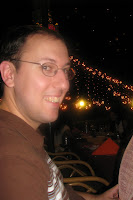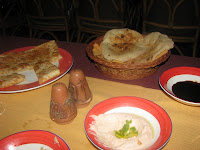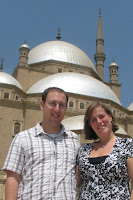 From Rwanda, I flew to Nairobi with a long 4 hour layover and then to Cairo. I didn't realize my itinerary included a fuel stop in Khartoum until we landed there. I was too embarrassed to ask anyone next to me- where the heck is Khartoum? Once we got to the gate, I saw a row of Sudan-Air planes and realized it must be the capital of Sudan. It was 11 pm when I arrived in the Cairo airport.
From Rwanda, I flew to Nairobi with a long 4 hour layover and then to Cairo. I didn't realize my itinerary included a fuel stop in Khartoum until we landed there. I was too embarrassed to ask anyone next to me- where the heck is Khartoum? Once we got to the gate, I saw a row of Sudan-Air planes and realized it must be the capital of Sudan. It was 11 pm when I arrived in the Cairo airport.
Everything about Egypt seemed so different; the Arabic words and numbers were undecipherable; lining up in an orderly way for things like Visa's and customs seemed optional (later I realized this is true of the traffic pattern too); and fully covered Muslim women everywhere was interesting. Many men were wearing long white robes and turbans or belts and flip flops. I noticed the heat right away; it is much hotter than Rwanda. I expected the terrain to be desert-like but actually Cairo is quite lush with many palm trees beside the Nile River. Here is a view of the Nile from our tower at the Marriott. We stayed at the Marriott because we thought a large touristy hotel would be sure food is available during the day during this Ramadan month. The hotel was lovely with more than 6 restaurants, a large courtyard, beautiful pool /sauna open 24 hours, and nice staff. Paul is standing next to one of the colorful Egyptian lanterns lighting the gardens at the hotel.
We stayed at the Marriott because we thought a large touristy hotel would be sure food is available during the day during this Ramadan month. The hotel was lovely with more than 6 restaurants, a large courtyard, beautiful pool /sauna open 24 hours, and nice staff. Paul is standing next to one of the colorful Egyptian lanterns lighting the gardens at the hotel.
We had dinner at the Egyptian Nights restaurant in the courtyard. It was late but still very busy, including live music. During Ramadan most people sleep late and once the sun sets enjoy lots of feasting and celebrating late into the night. The hotel had Christmas-like lights up for Ramadan including the words "Ramadan Kariim" strung accross the tall towers, which means having a generous month. We were excited to try the traditional foods in Egypt like kofta (type of meatball), hummos, babaganoush, pita puffs, lamb, and koshary (pasta, rice, lentil, chick peas, onions and garlic and chili sauce in one dish). Nearly every restaurant we saw was filled with people puffing on two-foot-tall water pipes called sheesha with fruit scented tobacco. It made the breezes smell sweet, but sometimes made the air smoky!
We were excited to try the traditional foods in Egypt like kofta (type of meatball), hummos, babaganoush, pita puffs, lamb, and koshary (pasta, rice, lentil, chick peas, onions and garlic and chili sauce in one dish). Nearly every restaurant we saw was filled with people puffing on two-foot-tall water pipes called sheesha with fruit scented tobacco. It made the breezes smell sweet, but sometimes made the air smoky!  The next morning we took a taxi to the Egyptian museum which houses the most extensive collection of Egyptian antiquities in the world with over 120,000 items. As we entered the museum courtyard we were asked if we wanted a guide. We decided to skip the extra fee (since we had to pay for the museum, also to store our cameras which were not allowed inside, and s again to go into the mummy room!) Of course, it turned out to be very hard to read all of the mostly Arabic signs by the artifacts, so we slyly tried to join other various tour groups and catch parts of the stories. The Royal Mummy Room has about 10 mummies displayed (one of which is a newly found queen). We learned the collection used to have over 20 mummies but a President in Egypt at one point ordered it closed due to the controversy of displaying mummmified remains. We learned alot about pharoahs, pyramids, jewelry, and statues.
The next morning we took a taxi to the Egyptian museum which houses the most extensive collection of Egyptian antiquities in the world with over 120,000 items. As we entered the museum courtyard we were asked if we wanted a guide. We decided to skip the extra fee (since we had to pay for the museum, also to store our cameras which were not allowed inside, and s again to go into the mummy room!) Of course, it turned out to be very hard to read all of the mostly Arabic signs by the artifacts, so we slyly tried to join other various tour groups and catch parts of the stories. The Royal Mummy Room has about 10 mummies displayed (one of which is a newly found queen). We learned the collection used to have over 20 mummies but a President in Egypt at one point ordered it closed due to the controversy of displaying mummmified remains. We learned alot about pharoahs, pyramids, jewelry, and statues.

After the museum we took another taxi to the Khan el-Khalili bazaar district which is a huge open market with windy alleys filled with shops. We were lured into many shops to check out the Egyptian goodies...carpets, lanters, stuffed camels, sheesha pipes, etc. Here is Paul in one of the many stores. I gave-in and bought a colorful scarab necklace which supposedly brings good luck.

We liked these foot stool/chairs but weren't sure what they are called; we decided to call them poofs because the salesman liked to spin them in the air to fluff them up before they land on the ground.
 Of course we bought a couple to bring home!
Of course we bought a couple to bring home! We tried to visit the famous Fashawi cafe near the market but it was closed for Ramadan. Instead, we sat at this small cafe and had a soda while many people tried to sell us jewelry and other souvenirs.
We tried to visit the famous Fashawi cafe near the market but it was closed for Ramadan. Instead, we sat at this small cafe and had a soda while many people tried to sell us jewelry and other souvenirs.


 After the show, we had dinner on one of the many boats parked on the Nile near our hotel. We enjoyed yummy Lebanese food at Dar El Amar on the Blue Nile boat.
After the show, we had dinner on one of the many boats parked on the Nile near our hotel. We enjoyed yummy Lebanese food at Dar El Amar on the Blue Nile boat.
The next day we did a three part tour of pyramids starting in Memphis, then to Saqqara to see the Step Pyramid, and last to Giza Plateau to see the Great Pyramids. Memphis is a city, once a capitol of Egypt, founded around 3,100 BC where a King united Upper and Lower Egypt. Today, it is pretty much ruins but we got our picture taken in front of the famous Alabaster Sphinx and checked out the gigantic Colossus of Ramses.







 We joined in the fun with our own poses.
We joined in the fun with our own poses.

 The second slightly smaller Pyramid for Kahfre, who was commonly considered the builder of the Great Sphinx. Casing stones cover the top third of the pyramid, but are missing on the bottom. We liked this Pyramid the best.
The second slightly smaller Pyramid for Kahfre, who was commonly considered the builder of the Great Sphinx. Casing stones cover the top third of the pyramid, but are missing on the bottom. We liked this Pyramid the best.

 We decided we should ride camels! We climbed on while they were sitting and then they leaned forward toward the ground as they stand up, snorting quite a bit while we held on tight.
We decided we should ride camels! We climbed on while they were sitting and then they leaned forward toward the ground as they stand up, snorting quite a bit while we held on tight.



 and was down on one knee, asking me to marry him.
and was down on one knee, asking me to marry him.


 The ring is so beautiful which he picked out all by himself.
The ring is so beautiful which he picked out all by himself. On another side destination after the Pyramids, the tour guide took us to a perfumery in Cairo. This is a very popular thing in Cairo; they claim to be the original blenders of perfume which is then the base of designer brand scents around the world. They brought us many different scents and we each bought a bottle of our favorite. (What can I say? We're suckers for souvenirs.)
On another side destination after the Pyramids, the tour guide took us to a perfumery in Cairo. This is a very popular thing in Cairo; they claim to be the original blenders of perfume which is then the base of designer brand scents around the world. They brought us many different scents and we each bought a bottle of our favorite. (What can I say? We're suckers for souvenirs.) We visited Alexandria City for a day, which is located north of Cairo on the Mediterranean Sea about 3 hours drive. It is the second largest city in Egypt, known as "The Pearl of the Mediterranean", andwas founded by Alexander the Great in 331 BC. We visited a public beach and rented chairs for a small fee.
We visited Alexandria City for a day, which is located north of Cairo on the Mediterranean Sea about 3 hours drive. It is the second largest city in Egypt, known as "The Pearl of the Mediterranean", andwas founded by Alexander the Great in 331 BC. We visited a public beach and rented chairs for a small fee. 

 There is an amazing modern library in Alexandria which had stacks and stacks of books as well as a private printing press, and three museums inside.
There is an amazing modern library in Alexandria which had stacks and stacks of books as well as a private printing press, and three museums inside. Paul and I picked out some books to look at.
Paul and I picked out some books to look at. The area of Islamic Cairo has a lot of old mosques, domes, towers, and palaces from the last five centuries. On our last day we toured the Saladin Citadel, one of the most popular places to visit in Cairo. Around 1176 AD Saladin decided to build a wall around Cairo.The Citadel is sometimes referred to as Mohamed Ali Citadel because it contains the Mosque of Muhammad Ali, which was built between 1828 and 1848on the summit of the citadel.
The area of Islamic Cairo has a lot of old mosques, domes, towers, and palaces from the last five centuries. On our last day we toured the Saladin Citadel, one of the most popular places to visit in Cairo. Around 1176 AD Saladin decided to build a wall around Cairo.The Citadel is sometimes referred to as Mohamed Ali Citadel because it contains the Mosque of Muhammad Ali, which was built between 1828 and 1848on the summit of the citadel.  The Mosque is very beautiful inside but I had to wear a robe because I was wearing a dress.
The Mosque is very beautiful inside but I had to wear a robe because I was wearing a dress. 




 who brought Paul a cake for his birthday.
who brought Paul a cake for his birthday.


1 comment:
What a "fairy-tale" adventure in Egypt! I am so happy for both of you!
Love You,
Mom
Post a Comment